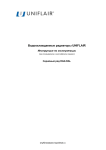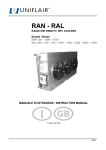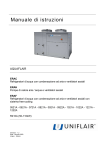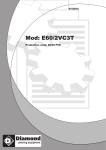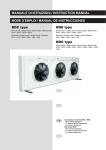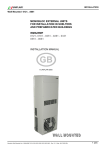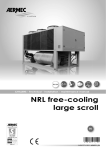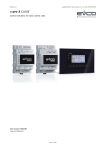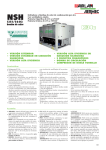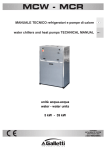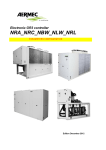Download MANUALE DI ISTRUZIONI / INSTRUCTION MANUAL
Transcript
MANUALE DI ISTRUZIONI / INSTRUCTION MANUAL CONDENSATORI AD ARIA / AIRCOOLED CONDENSER CAL CONDENSATORI AD ARIA / AIRCOOLED CONDENSER Modelli Mono-circuito / Single circuit model 0251 - 0331 - 0361 - 0511 0661 - 0801 - 1011 - 1301 Modelli Bi-circuito / Dual circuit model 1802 - 2002 - 3002 - 4002 - 5002 MANUALE DI ISTRUZIONI / INSTRUCTION MANUAL GB © UNIFLAIR 2004 CAL - Rev 2.3 – 24-02-2004 IT - EN 1 (28) MANUALE DI ISTRUZIONI / INSTRUCTION MANUAL CONDENSATORI AD ARIA / AIRCOOLED CONDENSER Alcune caratteristiche delle unità in versione speciale potrebbero discostarsi da quelle descritte nel presente manuale. The following general characteristics are relevant to standard units designed according to the available options found on the units price list. UNIFLAIR ITALIA S.p.A. Via dell’Industria, 10 35020 BRUGINE (Padova) Italy Tel. +39 (0)49 9713211 Fax. +39 (0)49 5806906 Internet: www.UNIFLAIR.com E-Mail: [email protected] Release: 2.3 Date: 24 – 02 - 04 Checked by: CAL - Rev 2.3 – 24.02.04 IT - EN 2 (28) MANUALE DI ISTRUZIONI / INSTRUCTION MANUAL CONDENSATORI AD ARIA / AIRCOOLED CONDENSER Indice Pagina 4 4 5 6 6 7 7 7 8 9 10 12 12 12 13 16 16 Simbologia Norme di sicurezza Descrizione generale Descrizione e destinazione d’uso Targa d'identificazione Trasporto e movimentazione Dimensioni e pesi Installazione Spazio operativo Dimensioni delle connessioni frigorifere Collegamenti frigoriferi Collegamenti elettrici Cavi d'alimentazione - protezioni Avviamento Organi di regolazione - taratura Manutenzione Ricerca guasti Index Symbols used Safety Instructions General Description Description and use Nameplate Transport - Positioning On Site Dimensions And Weight Installation Working Space Size of refrigerant connections Refrigerant Connections Electrical Connections Power Supply Cables - Protection Start-Up Control Devices - Adjustment Maintenance Fault Finding CAL - Rev 2.3 – 24-02-2004 IT - EN Page 17 17 18 19 19 20 20 20 21 22 23 25 25 25 26 29 29 3 (28) MANUALE DI ISTRUZIONI / INSTRUCTION MANUAL CONDENSATORI AD ARIA / AIRCOOLED CONDENSER SIMBOLOGIA SIMBOLO SIGNIFICATO PERICOLO GENERICO SIMBOLO SIGNIFICATO ORGANI IN MOVIMENTO AVVERTENZE IMPORTANTI SUPERFICI D'USTIONE CALDE, COMPONENTI IN TENSIONE, PERICOLO ELETTRICO SUFERFICI TAGLIENTI PERICOLO NORME DI SICUREZZA • • • • • • • • • Prima di qualsiasi intervento leggere attentamente il libretto d'istruzioni Il condensatore è pressato in fabbrica con azoto o con aria secca per prevenire l’ingresso d'umidità. Prima di rimuovere i tappi sugli attacchi in fase di installazione, scaricare l’azoto per mezzo della valvola a spillo sul collettore d’entrata. Il condensatore lavora in pressione: la manomissione dei raccordi o delle tubazioni può provocare fuoriuscite di gas compresso La tubazione d'ingresso al condensatore può assumere temperature superiori a 70°C e presenta quindi pericolo d'ustione INSTALLARE IL CONDENSATORE IN POSIZIONE INACCESSIBILE A PERSONE NON AUTORIZZATE: le alette dello scambiatore di calore sono in lamiera d'alluminio di piccolo spessore e possono tagliare in caso di contatto involontario. Il condensatore è in tensione e contiene parti rotanti: prima di intervenire su qualsiasi parte elettrica oppure sul ventilatore/i aprire il sezionatore (portare la manopola in posizione “O”) Tutte le operazioni di servizio o manutenzione devono essere effettuate con macchina ferma e devono essere condotte da personale esperto e qualificato. In caso d'incendio l’acqua e le altre sostanze conduttrici non devono essere usate per lo spegnimento in prossimità delle parti elettriche sotto tensione. Tale divieto dev’essere esposto nel luogo d'installazione della macchina, mediante avvisi. I refrigeranti impiegati, se direttamente a contatto con fiamme, si decompongono dando origine ad acidi o altre sostanze irritanti. L’odore acre di tali sostanze, già a concentrazioni minori dei valori pericolosi, dà un avvertimento tale da consentire l’evacuazione della zona a rischio. Assicurarsi che la tensione d'alimentazione corrisponda a quella riportata nei valori di targa. CAL - Rev 2.3 – 24.02.04 IT - EN 4 (28) MANUALE DI ISTRUZIONI / INSTRUCTION MANUAL CONDENSATORI AD ARIA / AIRCOOLED CONDENSER DESCRIZIONE GENERALE DISPOSIZIONE CON FLUSSO D’ARIA ORIZZONTALE Fig. 1.a. - CAL 0251…1301 Fig. 1.b. - CAL 1802…5002 DISPOSIZIONE CON FLUSSO D’ARIA VERTICALE Fig. 2.a. - CAL 0251…1301 1 2 3 4 5 6 7 N.B.: Fig. 2.b. - CAL 1802…5002 Ventilatore Staffe di supporto Gambe di supporto Connessioni frigorifere Sezionatore Regolatore di pressione Targa d'identificazione Il numero e la disposizione dei ventilatori varia con il modello di condensatore CAL - Rev 2.3 – 24-02-2004 IT - EN 5 (28) MANUALE DI ISTRUZIONI / INSTRUCTION MANUAL CONDENSATORI AD ARIA / AIRCOOLED CONDENSER DESCRIZIONE E DESTINAZIONE D’USO Condensatori remoti con ventilatore assiale a basso numero di giri idonei ad installazione all’aperto, completamente assemblati e collaudati in fabbrica. I condensatori possono essere installati sia in posizione verticale (flusso aria orizzontale) oppure in posizione orizzontale (flusso aria verticale). Le unità sono dotate di controllo della pressione di condensazione per ciascun circuito, nelle unità bicircuito è standard il controllo modulante della velocità dei ventilatori con regolatore a taglio di fase: in questo caso è data priorità al circuito in cui la pressione è maggiore. Carrozzeria: i condensatori CAL sono realizzati con struttura autoportante in alluminio goffrato con elevatissima resistenza alla corrosione. Ventilatori: di tipo assiale bilanciati staticamente e dinamicamente su due piani, con pale di disegno innovativo realizzate in alluminio pressofuso. Il motore elettrico è del tipo a rotore esterno, IP54 classe “F”, particolarmente adatto alla regolazione di velocità con sistemi a taglio di fase. La griglia di sicurezza a protezione del ventilatore è conforme alle vigenti norme di sicurezza. Batteria condensante: ad ampia superficie frontale e disposta a monte dei ventilatori per un’ottimale distribuzione dell’aria. É realizzata con tubi in rame espansi meccanicamente su alette d’alluminio. Collegamenti frigoriferi: le connessioni sono di tipo ROTALOCK maschio disposte su un lato dell’unità per un collegamento rapido e sicuro alle tubazioni provenienti dall’unità motoevaporante. Impianto elettrico: interruttore sezionatore generale con grado di protezione IP44 per le unità monocircuito e IP65 per la unità bicircuito disposto sul lato ventilatori dell’unità, regolatori di pressione precablati e (sulle unità bicircuito) protetti da un’opportuna carenatura. TARGA D'IDENTIFICAZIONE La targhetta d'identificazione, applicata sul condensatore, riporta le seguenti indicazioni: • Modello della macchina; • Numero di matricola; • Anno di costruzione; • Corrente e potenza assorbite; • Valori di taratura standard. CAL - Rev 2.3 – 24.02.04 IT - EN 6 (28) MANUALE DI ISTRUZIONI / INSTRUCTION MANUAL CONDENSATORI AD ARIA / AIRCOOLED CONDENSER TRASPORTO E MOVIMENTAZIONE Il condensatore ha lasciato la fabbrica in perfetto stato; al momento della consegna; controllarne l’integrità e notificare subito per iscritto al trasportatore ogni danno che possa essere attribuito ad un trasporto rude. Durante il trasporto e il tiro in sito: • non reclinare o capovolgere il condensatore. • prima di rimuovere l’imballo, trasportare il condensatore nel punto più vicino al luogo d'installazione per mezzo di un transpallet oppure di un carrello trasportatore stabile, assicurando l’unita’ per evitarne il ribaltamento. • rimuovere l’imballo prestando attenzione a non danneggiare l’unità. La simbologia applicata sull’imballo è conforme alla norma ISO7000; il significato dei segni grafici è riportato in tabella. SEGNO GRAFICO SIGNIFICATO FRAGILE: manipolare precauzione. con TEME L’UMIDITÁ: indica che l’imballaggio dev’essere tenuto in luogo asciutto. CENTRO DI GRAVITÁ: indica il centro di gravità dell’imballaggio di spedizione. TEME IL CALORE: indica che l’imballaggio di spedizione deve essere tenuto distante da fonti di calore. SEGNO GRAFICO SIGNIFICATO ALTO: indica la posizione corretta dell’imballaggio di spedizione. LIMITI DI TEMPERATURA: indica i limiti di temperatura entro i quali l’imballaggio dev’essere conservato e manipolato. NON UTILIZZARE GANCI: indica che sono proibiti i ganci per il sollevamento dell’imballaggio di spedizione. NON SOVRAPPORRE gli imballi. DIMENSIONI E PESI Vedi disegni allegati DIUI... INSTALLAZIONE Porre il condensatore all’aperto evitando l’esposizione all’insolazione diretta. Esso può essere installato: • con flusso d’aria orizzontale (versione standard) per una migliore protezione (dalla neve o da oggetti provenienti dall’alto) e una più facile manutenzione; con quest'assetto il condensatore necessita di protezione dal vento che potrebbe interferire con il funzionamento del ventilatore; • con flusso d’aria verticale; quest'assetto è consigliato per l’installazione in zone ventose o laddove il flusso d’aria orizzontale sia ostruito ed è realizzabile per mezzo del kit gambe opzionale (4 gambe per i modelli: 0251…0661 e 1802…4002; 6 gambe per i modelli: 0801…1301 e 5002). Per le operazioni di montaggio vedi lo schema allegato al kit gambe. Il peso contenuto dei condensatori CAL ne permette l’installazione su solette di portata modesta. Poggiare il condensatore su una superficie solida e piana. Se necessario livellare con spessori in modo che la pendenza non superi 1 grado. Fissare il condensatore utilizzando gli appositi fori sulle staffe di base (flusso d’aria orizzontale) oppure sulle estremità inferiori delle gambe (flusso d’aria verticale). CAL - Rev 2.3 – 24-02-2004 IT - EN 7 (28) MANUALE DI ISTRUZIONI / INSTRUCTION MANUAL CONDENSATORI AD ARIA / AIRCOOLED CONDENSER SPAZIO OPERATIVO Rispettare le distanze minime indicate in fig. 3, necessarie per una libera circolazione dell’aria e per la manutenzione dell’unità. > 0,7 m >4m >1m >4m >1m Fig. 3.a.: FLUSSO D’ARIA ORIZZONTALE Fig. 3.b.: FLUSSO D’ARIA VERTICALE INSTALLARE IL CONDENSATORE IN POSIZIONE INACCESSIBILE A PERSONE NON AUTORIZZATE: L’alettatura dello scambiatore di calore è in lamiera d'alluminio spessa 0,1 mm ed è potenzialmente tagliente in caso di violento contatto involontario. NB: la caratteristica dei ventilatori non consente la canalizzazione dell’aria. CAL - Rev 2.3 – 24.02.04 IT - EN 8 (28) MANUALE DI ISTRUZIONI / INSTRUCTION MANUAL CONDENSATORI AD ARIA / AIRCOOLED CONDENSER DIMENSIONI DELLE CONNESSIONI FRIGORIFERE Il condensatore è provvisto di connessioni tipo ROTALOCK maschio. Fig. 4.a. Gli attacchi rotalock diritti femmina forniti a corredo dell’unità (fig. 4.b.) devono essere avvitati sui rubinetti del gas e del liquido verificando che siano presenti le guarnizioni bianche in teflon. linea del liquido 1” maschio (0251…0361) 1 ¼" maschio (0511…5002) Attacco rotalock femmina per la linea del liquido linea del gas 1” maschio (0251…0361) 1 ¼" maschio (0511…1802) 1 ¾" maschio (2002…5002) Attacco rotalock femmina per la linea del gas ODS ODS ØINTERNO 12 mm ØINTERNO 16 mm (0251-0331) (0251-0331-0361) ØINTERNO 16 mm ØINTERNO 18 mm (0361-0511-0661) (0511-0661) ØINTERNO 18 mm ØINTERNO 22 mm (0801-1011-1301) (0801-1011-1301) ØINTERNO 22 mm ØINTERNO 28 mm (1802) (1802) ØINTERNO 28 mm ØINTERNO 35 mm (2002-3002-4002-5002) (2002-3002-4002) ØINTERNO 42 mm Fig. 4.b. (5002) In alternativa agli attacchi femmina diritti possono essere forniti a richiesta: - giunti ad angolo (vedi fig. 5.a.); - rubinetti d'intercettazione (vedi fig. 5.b.). A B A: ATTACCO ROTALOCK MASCHIO B: GUARNIZIONE A B Fig. 5.a. CAL - Rev 2.3 – 24-02-2004 IT - EN Fig. 5.b. 9 (28) MANUALE DI ISTRUZIONI / INSTRUCTION MANUAL CONDENSATORI AD ARIA / AIRCOOLED CONDENSER NOTA: Il diametro delle linee frigorifere tra condizionatore e condensatore remoto (De) dev'essere scelto in funzione della lunghezza delle stesse, pertanto non sempre coinciderà con il diametro interno (ODS) dell'attacco rotalock fornito da UNIFLAIR. De Fig. 6. COLLEGAMENTI FRIGORIFERI Il condensatore è pressato in fabbrica con aria secca (modelli 0251…1301) o azoto (modelli 1802…5002) per prevenire l’ingresso d'umidità e chiuso con tappi. PRIMA DI RIMUOVERE I TAPPI SUGLI ATTACCHI SCARICARE L’AZOTO PER MEZZO DELLA VALVOLA A SPILLO SUL COLLETTORE D’ENTRATA. A A A A D E B B E 1 2 C 3 4 Fig. 7. 1. Svitare il tappo giallo (E) avvitato sull’attacco rotalock (A); 2. Rimuovere la guarnizione nera in gomma (D): questa guarnizione è utilizzata solamente per garantire la tenuta del circuito precaricato con azoto o aria secca; 3. Verificare che sia presente la guarnizione bianca in teflon (B) sull’attacco rotalock (A); 4. Avvitare il giunto (C) sull’attacco (A). CAL - Rev 2.3 – 24.02.04 IT - EN 10 (28) MANUALE DI ISTRUZIONI / INSTRUCTION MANUAL CONDENSATORI AD ARIA / AIRCOOLED CONDENSER Rispettare il corretto collegamento del condensatore evitando di invertire l’ingresso con l’uscita (vedi fig. 8). OK Fig. 8.a. Fig. 8.b. La stesura delle linee, con un percorso complessivo preferibilmente inferiore a 30 metri, deve essere realizzata da un esperto tecnico frigorista secondo le seguenti indicazioni (vedi figure). Unità Interna Unità interna ISOLAMENTO TERMICO 1/100 1/100 ISOLAMENTO TERMICO MANDATA LIQUIDO MAX 5 METRI MAX 30 METRI MANDATA Fig. 9.a • • • • • Realizzare per quanto possibile linee rettilinee; Inclinare il tubo di mandata con pendenza 1/100 nella direzione del flusso per facilitare il trascinamento dell’olio; Sifonare il tubo di mandata alla base degli eventuali montanti verticali; Isolare il tubo del refrigerante liquido in caso di esposizione al sole; Evitare qualsiasi contatto tra il tubo di mandata e il tubo del liquido. Effettuare quindi le operazioni di vuoto e carica dell’intero circuito frigorifero. Fig. 9.b LIQUIDO Fig. 9.c MANDATA 1/100 Unità interna LIQUIDO MAX 5 METRI MAX 15 METRI ISOLAMENTO TERMICO MAX 5 METRI N.B.: la tubazione del liquido deve essere protetta dalla radiazione solare SIFONE CAL - Rev 2.3 – 24-02-2004 IT - EN 11 (28) MANUALE DI ISTRUZIONI / INSTRUCTION MANUAL CONDENSATORI AD ARIA / AIRCOOLED CONDENSER COLLEGAMENTI ELETTRICI La corretta esecuzione degli allacciamenti elettrici, a regola d’arte e nel rispetto delle norme vigenti, è importante ai fini della prevenzione degli infortuni e del buon funzionamento, inalterato nel tempo, del condensatore. Prima di eseguire qualsiasi operazione su parti elettriche, assicurarsi che non vi sia tensione e che il sezionatore di bordo sia aperto (in posizione “O”); CAVI DI ALIMENTAZIONE - PROTEZIONI (vedi schema elettrico allegato SECA...) Il condensatore ha un funzionamento automatico ed autonomo (in funzione della pressione del refrigerante) e quindi la sua alimentazione elettrica non deve provenire dall’unità cui esso è collegato bensì dal quadro elettrico più vicino o più conveniente. Verificare che la tensione e la frequenza di rete corrispondano ai valori riportati sulla targa di identificazione del condensatore. Collegare il cavo di alimentazione al sezionatore introducendo il cavo nella scatola attraverso un passacavo IP55 e serrare a fondo le viti dei morsetti. Nella tabella seguente sono elencati i dati elettrici principali utili per il dimensionamento del cavo di alimentazione. CAL0251 CAL0331 CAL0361 CAL0511 CAL0661 CAL0801 CAL1011 CAL1301 NUM kW FLA TENSIONE NUM kW OA FLA 230V/1/50Hz 230V/1/50Hz 230V/1/50Hz 230V/1/50Hz 230V/1/50Hz 230V/1/50Hz 230V/1/50Hz 230V/1/50Hz 1 1 2 2 2 3 3 4 0.18 0.18 0.36 0.36 0.36 0.54 0.54 0.72 0.87 0.87 1.74 1.74 1.74 2.61 2.61 3.48 1.0 1.0 2.0 2.0 2.0 3.0 3.0 4.0 : kW : A : CAL1802 CAL2002 CAL3002 CAL4002 CAL5002 TENSIONE NUM kW FLA 230V/1/50Hz 230V/1/50Hz 230V/1/50Hz 230V/1/50Hz 230V/1/50Hz 2 2 3 3 4 1.56 1.56 2.34 2.34 3.12 7.0 7.0 10.5 10.5 14.0 Numero di ventilatori Potenza Nominale Complessiva Assorbimento massimo Complessivo NOTA BENE: il condensatore è provvisto di protezione contro il sovraccarico (interruttore bimetallico in ciascun motore) ma non contro il corto circuito; si consiglia l'utilizzo di un fusibile di back-up (o interruttore automatico di portata adeguata) a monte della linea di alimentazione per correnti di cortocircuito Icc fino a 10kA. AVVIAMENTO Alimentare il condensatore e chiudere il sezionatore (portare la manopola in posizione “I”). Il ventilatore si attiva automaticamente quando la pressione di condensazione del refrigerante inviato dal compressore raggiunge il valore di intervento del regolatore di pressione (pre-tarato in fabbrica). La verifica del funzionamento del condensatore è quindi conseguente all’avviamento del compressore del circuito frigorifero di cui esso fa parte. CAL - Rev 2.3 – 24.02.04 IT - EN 12 (28) MANUALE DI ISTRUZIONI / INSTRUCTION MANUAL CONDENSATORI AD ARIA / AIRCOOLED CONDENSER ORGANI DI REGOLAZIONE - TARATURA Il condensatore è dotato di un organo di regolazione della pressione di condensazione consistente alternativamente in: 1. Regolatore continuo di velocità (versione costruttiva P - standard); 2. Pressostato ON-OFF (CAL monocircuito in versione costruttiva S - a richiesta); 3. VARICOND: regolatore a gradini con alimentazione ad autotrasformatore (CAL monocircuito in versione costruttiva V - a richiesta). L’organo di regolazione è pretarato in fabbrica. Per verificare il valore di taratura collegare un manometro con fondo scala di almeno 30 bar alla presa di pressione posta sul collettore d'ingresso del condensatore e seguire il funzionamento del ventilatore in funzione della pressione. In caso di modifica della taratura, seguire le istruzioni seguenti e verificare il nuovo valore come spiegato sopra. Prima di eseguire qualsiasi operazione, assicurarsi che il sezionatore sia aperto (manopola in posizione “O”). REGOLATORE CONTINUO DI VELOCITÁ (versione costruttiva P - standard) Il ventilatore V è alimentato attraverso un regolatore di tensione R a TRIAC sensibile alla pressione di condensazione (fig. 10). ~ La tensione in uscita dal regolatore (e quindi la velocità del ventilatore) varia tra un massimo del 95% e un minimo del 40% della tensione di rete (risp. tra circa 220V e 90V per rete a 230V) con il variare della pressione di condensazione in un intervallo di 5 bar (banda proporzionale PROP): vedi fig. 11. R V Vout Fig.10 VOLT 95% Vout 45 % 0 PROP MIN P - bar SET Fig.11. Questo sistema di regolazione è idoneo per temperature esterne non inferiori a -20°C. Il punto di taratura SET della pressione, corrispondente alla massima tensione in uscita, è tarabile sull’elemento sensore mediante la vite di regolazione indicata con 1 nella fig. 12. Al di sotto della pressione minima di lavoro MIN (limite inferiore della banda proporzionale) il ventilatore deve fermarsi: per fare ciò il potenziometro indicato con 2 nella fig. 12 deve essere completamente ruotato in senso antiorario (altrimenti al diminuire della pressione il ventilatore continuerebbe a girare, anche se a velocità ridotta, facendo perdere il controllo della pressione di condensazione a basse temperature esterne). L’ampiezza della banda proporzionale PROP non è tarabile. 2 1 Fig.12. Valore di taratura consigliato (pretaratura in fabbrica): SET = 21 bar CAL - Rev 2.3 – 24-02-2004 IT - EN 13 (28) REGOLATORE DI VELOCITA’ CONDENSANTI BICIRCUITO TARATURA di fabbrica per Factory CALIBRATION for Banda Proporzionale Set-Point Soft-Start Vel. MAX P1 DL1 M P2 m M P3 m M P4 m m Cut-Off P5 M m M 1 2 SOFT START RGF PROP. BAND SET POINT MAX OUT J1 Selezione: MODO Cut-Off MODO Vel. MIN CUT-OFF 0-30 bar 0-30 bar P1 M m SOFT START 2 sec. P2 M m PROP. BAND 2.5 mA 4.6 bar P3 M m SET POINT P4 m P5 m M MAX OUT 100% 230VAC M CUT-OFF M m 17.3 bar M m 15.0 bar M m 20.0 bar 14 (28) MANUALE DI ISTRUZIONI / INSTRUCTION MANUAL CONDENSATORI AD ARIA / AIRCOOLED CONDENSER Nella parte di controllo sono presenti gli organi di regolazione, ovvero: • Trimmers : indicati con ‘Pn’ • Ponticelli : indicati con 'Jn' • Led: indicati con 'Dln' DL1 Led VERDE di segnalazione "erogazione di tensione al carico in corso" Nella parte di potenza sono presenti organi di collegamento, ovvero: • Morsettiera di potenza: morsettiera Alimentazione, per il collegamento dell’alimentazione e del carico (es.: ventilatori) • Morsettiera di comando: per il collegamento dei segnali di comando (ovvero di due sonde/trasduttori o di due regolatori ausiliari di comando remoto) Precauzioni: • rimontare e verificare sempre la perfetta chiusura del coperchio di protezione esterno. • non alterare o danneggiare gli adesivi di identificazione delle apparecchiature. • non forzare mai la rotazione dei trimmer oltre la corsa meccanica prevista. • modificare unicamente la posizione dei trimmer indicati per la regolazione. non modificare in nessun caso i trimmer con il punto rosso di vernice. Prima di eseguire qualsiasi operazione, assicurarsi che il sezionatore sia aperto CAL - Rev 2.3 – 24-02-2004 IT - EN 15 (28) MANUALE DI ISTRUZIONI / INSTRUCTION MANUAL CONDENSATORI AD ARIA / AIRCOOLED CONDENSER MANUTENZIONE • Controllare frequentemente lo stato di pulizia del condensatore; rimuovere dallo scambiatore di calore alettato tutti i corpi estranei (foglie, semi, polvere) con un getto d’aria compressa. Le alette dello scambiatore di calore sono in lamiera di alluminio di piccolo spessore e possono tagliare in caso di contatto involontario. • • Verificare che il funzionamento e l’assorbimento elettrico di ciascun ventilatore siano regolari e senza rumori anomali; Controllare che l’organo di regolazione funzioni regolarmente (vedi par. ORGANI DI REGOLAZIONE TARATURA); RICERCA GUASTI ATTENZIONE: PRIMA DI INTERVENIRE SUL CONDENSATORE LEGGERE ATTENTAMENTE LE NORME DI SICUREZZA ALL’INIZIO DI QUESTO MANUALE La funzionalità del condensatore è strettamente legata alle condizioni di lavoro dell’unità cui esso è collegata e quindi eventuali inconvenienti apparentemente attribuibili al condensatore potrebbero dipendere da cause esterne ad esso. Nella tabella seguente sono elencati gli inconvenienti più probabili. INCONVENIENTE CAUSA POSSIBILE CONTROLLO/AZIONE CORRETTIVA ALTA PRESSIONE DI MANDATA : INTERVIENE IL PRESSOSTATO DI ALTA PRESSIONE DEL CONDENSATORE A) Lo scambiatore alettato è sporco o occluso da oggetti estranei B) Aria troppo calda al condensatore Pulire lo scambiatore alettato osservando le avvertenze del par. MANUTENZIONE 1) Controllare la presenza di eventuali ricircoli (non dipendente da cause estranee al condensatore quali, ad esempio: • gas non condensabili nel circuito • valvole parzialmente chiuse sul tratto di tubazione in mandata tra il compressore e il condensatore • pressione di aspirazione troppo elevata • circuito troppo carico di refrigerante con eccessivo sottoraffreddamento al condensatore) BASSA PRESSIONE DI MANDATA C) Scarso flusso d’aria di condensazione D) Uno o più ventilatori sono fuori servizio E) Organo di regolazione starato o guasto A) Organo di regolazione starato o guasto B) Fuga di refrigerante CAL - Rev 2.3 – 24.02.04 IT - EN dell’aria di condensazione 2) Verificare che la temperatura dell’aria di condensazione non superi il valore di progetto Controllare che il condensatore sia installato rispettando le distanze minime (vedi paragrafo INSTALLAZIONE) Verificare l’eventuale intervento della protezione interna del motoventilatore non funzionante; eventualmente sostituire il motoventilatore Verificare la taratura dell’organo di taratura (vedi par. ORGANI DI REGOLAZIONE - TARATURA); se necessario sostituirlo Verificare la taratura dell’organo di taratura (vedi par. ORGANI DI REGOLAZIONE - TARATURA); se necessario sostituirlo Eliminare la fuga e ripristinare la carica 16 (28) MANUALE DI ISTRUZIONI / INSTRUCTION MANUAL CONDENSATORI AD ARIA / AIRCOOLED CONDENSER SYMBOLS USED SYMBOL MEANING DANGER SYMBOL MEANING MOVING PARTS IMPORTANT WARNING HOT SURFACE LIVE COMPONENTS – RISK OF ELECTRIC SHOCK SHARP SURFACES SAFETY INSTRUCTIONS • • • • • • • • • READ THE INSTRUCTION MANUAL CAREFULLY BEFORE CARRYING OUT ANY WORK ON THE EQUIPMENT. The condenser is factory precharged with dry nitrogen or with dry air to prevent the ingress of any water vapour. Before removing the plugs from the inlet and outlet connections for installation, discharge the nitrogen by means of the needle valve on the inlet manifold The condenser contains gas above atmospheric pressure: tampering with connections or pipework can cause leakage of compressed gas The temperature of the inlet pipe to the condenser can rise above 70°C and therefore presents the risk of burns INSTALL THE CONDENSER IN A POSITION WHICH IS INACCESSIBLE TO UNAUTHORISED PERSONNEL: the fins of the heat exchanger are made from thin aluminium sheet and can cause cuts in the event of accidental contact. The condenser contains live electrical parts and rotating devices: before carrying out any work on the electrics or on the fan, isolate the unit (turn optional isolator to position ‘O’) All service and maintenance operations which require access to the inside of the unit while it is in operation must be performed by qualified and experienced personnel who are aware of the precautions which must be taken. In the event of fire, water and other conductive substances must not be used to put out the fire near live electrical components. This warning must be displayed on notices in the unit installation location. If the refrigerants used come into contact with fire they decompose, forming acids and other irritants. The smell of these substances, even at concentrations below danger levels, gives enough warning to allow evacuation of the area at risk. Make sure that the power supply voltage corresponds to the value shown on the data plate. CAL - Rev 2.3 – 24-02-2004 IT - EN 17 (28) MANUALE DI ISTRUZIONI / INSTRUCTION MANUAL CONDENSATORI AD ARIA / AIRCOOLED CONDENSER GENERAL DESCRIPTION HORIZONTAL AIR DISCHARGE ARRANGEMENT Fig. 1.a. - CAL 0251…1301 Fig. 1.b. - CAL 1802…5002 VERTICAL AIR DISCHARGE ARRANGEMENT Fig. 2.a. - CAL 0251…1301 1 2 3 4 5 6 7 N.B.: Fig. 2.b. - CAL 1802…5002 Propeller Fan Holding Brackets Holding Legs Connections Mains Isolator Pressure Regulator Identification Plate Fan number and layout depend on condenser model CAL - Rev 2.3 – 24.02.04 IT - EN 18 (28) MANUALE DI ISTRUZIONI / INSTRUCTION MANUAL CONDENSATORI AD ARIA / AIRCOOLED CONDENSER DESCRIPTION AND USE Remote condensers with axial fans for outdoor installation, fully factory assembled and tested. The condenser can be installed in a vertical position with horizontal air flow or, with the addition of appropriate brackets, in a horizontal position with vertical air flow. Units are equipped with condensation pressure control on each circuit. On Dual circuit condensers the modulating fan speed control is equipped with a an adjustable speed control, in this case, the circuit with the higher pressure is given priority. Case: self supporting and constructed entirely in aluminium for outdoor installation in demanding operating conditions. Fan motor: of the axile type, statically and dinamically balanced, with innovative blade design built in die-cast alluminium. Electric motor is of the outside-rotor type, protection grade IP54, CLASS "F", offering the opportunity for a stepless speed adjustment via a TRIAC voltage controller. Safety protection grilles fitted on the fans comply with safety standards. Condensing Coil: with large frontal area, upstream the fans for an efficient air distribution, constructed of copper tubes mechanically expanded into aluminium fins. Refrigerant connections: Rotalock type connections, located on one side of the condenser for the rapid and secure connection to the refrigerant pipe lines from/to the motoevaporating unit. Electrical Panel: main Switch in an IP 44 box (single circuit) and IP65 box (Dual circuit) the electric connection box is located on the fan’s side of the condenser and is easily accessible from the outside. Pressure regulator device is (Dual circuit) protected by means of an aluminium cover on one side of the condenser. NAMEPLATE The nameplate, located on condenser, contains the following data: • Unit model; • Serial number; • Year of manufacture; • Current and power absorbed; • Standard settings. CAL - Rev 2.3 – 24-02-2004 IT - EN 19 (28) MANUALE DI ISTRUZIONI / INSTRUCTION MANUAL CONDENSATORI AD ARIA / AIRCOOLED CONDENSER TRANSPORT - POSITIONING ON SITE The condenser leaves the factory in perfect condition, at the moment of delivery its condition should be carefully checked and any damage which might have been caused in transit should be notified in writing to the haulier. During transit and positioning on site: • Do not overturn or lean the condenser on its side. • Before removing the packaging carry the condenser to the nearest possible point to the actual installation location by using a pallet truck or a forklift securing the unit to ensure that it does not fall off. • remove all packing with care, make sure that the unit is not damaged in any way. The symbols shown on the unit packaging conform to ISO7000 standards. Their meaning is explained in the table below. SYMBOL MEANING FRAGILE: handle with care. SYMBOL MEANING THIS SIDE UP shows the orientation of the unit. PROTECT AGAINST MOISTURE: the packed unit must be stored in a dry place. TEMPERATURE LIMITS: the unit must not be stored outside these limits. CENTRE OF GRAVITY: shows the centre of gravity of the packed unit. NO HOOKS: do not use hooks to lift the packed unit. KEEP AWAY FROM HEAT: the unit must be kept away from heat sources. DO NOT STACK DIMENSIONS AND WEIGHT See drawing DIUI ........... attached. INSTALLATION Position the condenser in the open air out of direct sunlight. It can be installed: • with horizontal air discharge (standard version) for best protection (from snow or from objects falling from above) and easier maintenance; in this configuration the condenser must be protected from the wind which could interfere with the operation of the fan; • with vertical air discharge ; this configuration is recommended for installation in windy locations or where a horizontal air flow would be easily obstructed, available with optional leg kit (four legs on models 0251…0661 and 1802…4002; six legs on models 0801…1301 and 5002). Leg kit includes assembly instructions. The limited weight of the CAL condensers means that they can be installed on relatively lightweight bases. Position the condenser on a solid, level surface. Use shims if necessary to ensure a level installation to within one degree. Fix the condenser down using the appropriate bolt holes in the base (horizontal air discharge) or in the bottoms of the legs (vertical air discharge) CAL - Rev 2.3 – 24.02.04 IT - EN 20 (28) MANUALE DI ISTRUZIONI / INSTRUCTION MANUAL CONDENSATORI AD ARIA / AIRCOOLED CONDENSER WORKING SPACE Indicated in fig. 3, minimum recommended distance to be left clear for a correct unit function and to allow access to the unit for maintenance. > 0,7 m >4m >1m >4m >1m Fig. 3.a.: HORIZONTAL AIR FLOW Fig. 3.b.: VERTICAL AIR FLOW INSTALL THE CONDENSER IN A POSITION WHICH IS INACCESSIBLE TO UNAUTHORISED PERSONNEL: The heat exchanger fins are made from aluminium sheet which is only 0.1 mm thick and could cause cuts in the event of forceful accidental contact. N.B. the fan characteristic does not allow any ducting of the air flow. CAL - Rev 2.3 – 24-02-2004 IT - EN 21 (28) MANUALE DI ISTRUZIONI / INSTRUCTION MANUAL CONDENSATORI AD ARIA / AIRCOOLED CONDENSER SIZE OF REFRIGERANT CONNECTIONS The condenser has male rotalock connections. Fig. 4.a. Fitted inside the air conditioner are straight female ROTALOCK valves (fig. 4.b.) They must be connected to the gas and liquid line connections. Check that the white teflon gasket is fitted. liquid line 1” male (0251…0361) 1 ¼" male (0511…5002) Female rotalock liquid line connection gas line 1” male (0251…0361) 1 ¼" male (0511…1802) 1 ¾" male (2002…5002) Female rotalock gas line connection ODS Fig. 4.b. ODS ØINNER 12 mm ØINNER 16 mm (0251-0331) (0251-0331-0361) ØINNER 16 mm ØINNER 18 mm (0361-0511-0661) (0511-0661) ØINNER 18 mm ØINNER 22 mm (0801-1011-1301) (0801-1011-1301) ØINNER 22 mm ØINNER 28 mm (1802) (1802) ØINNER 28 mm ØINNER 35 mm (2002-3002-4002-5002) (2002-3002-4002) ØINNER 42 mm (5002) The following optionals can be fitted in alternative to straight female connections : - right angle connectors (vedi fig. 5.a.); - service valves (vedi fig. 5.b.). A B A: MALE ROTALOCK VALVE B: SEAL A B Fig. 5.a. CAL - Rev 2.3 – 24.02.04 IT - EN Fig. 5.b. 22 (28) MANUALE DI ISTRUZIONI / INSTRUCTION MANUAL CONDENSATORI AD ARIA / AIRCOOLED CONDENSER NB: the diameter of the refrigerant line that connects the unit to its remote condenser (De) must be chosen according to the length of the refrigerant line itself. The size will not always coincide with the internal diameter (ODS) of the rotalock valves supplied by UNIFLAIR. De Fig. 6. REFRIGERANT CONNECTIONS The condenser is factory charged with dry air (model 0251…1301) or dry nitrogen (model 1802…5002) to prevent the entry of humidity, the connections are sealed with plugs. BEFORE REMOVING THE PLUGS FROM THE CONNECTIONS, DISCHARGE THE NITROGEN BY MEANS OF THE NEEDLE VALVE ON THE INLET MANIFOLD. A A A A D E B B E 1 2 C 3 4 Fig. 7. 1. Unscrew the yellow cap (E) on the rotalock connection (A); 2. Remove the black rubber seal (D): this is only used to seal the circuit charged with nitrogen;or dry air; 3. Check that the white teflon seal (B) is on the rotalock connection (A); 4. Screw the joint (C) on to the connection (A). CAL - Rev 2.3 – 24-02-2004 IT - EN 23 (28) MANUALE DI ISTRUZIONI / INSTRUCTION MANUAL CONDENSATORI AD ARIA / AIRCOOLED CONDENSER Take care that the connections are correctly made and in particular do not invert the inlet and outlet connections (fig. 8). OK Fig. 8.a. Fig. 8.b. It is recommended that the piping, whose total length should preferably not exceed 30 metres, be installed by an expert refrigeration operator according to the following instructions (see fig.). Internal unit Internal unit THERMAL INSULATION THERMAL INSULATION 1/100 1/100 DISCHARGE LIQUID MAX 5 METRES MAX 30 METRES DISCHARGE Fig. 9.a • • • • • Where possible make straight lines; incline the discharge line with a gradient of 1/100 in the direction of flow to facilitate oil entrainment; make a ‘U’ trap in the discharge line at the bottom of any vertical risers; thermally insulate the refrigerant liquid line wherever it may be exposed to sun; avoid any contact between the discharge line and the liquid line. Carry out the evacuation and charging of the complete refrigerant circuit. N.B.: liquid piping must be protected from solar radiation or other heat sources Fig. 9.b LIQUID Fig. 9.c DISCHARGE 1/100 Internal unit LIQUID MAX 5 METRES MAX 15 METRES THERMAL INSULATION MAX 5 METRES SIPHON CAL - Rev 2.3 – 24.02.04 IT - EN 24 (28) MANUALE DI ISTRUZIONI / INSTRUCTION MANUAL CONDENSATORI AD ARIA / AIRCOOLED CONDENSER ELECTRICAL CONNECTIONS A correct electrical connection, carried out accurately and in compliance with local regulations, is extremely important in order to prevent accidents and to ensure long trouble free operation. Before working on the electrical parts of the unit, make sure that the power is off and that the isolator switch on the electrical panel is in the “O” position; POWER SUPPLY CABLES - PROTECTION (see wiring diagram SECA ......... attached) The condenser can be operated automatically and autonomously (as a function of the refrigerant pressure ) and therefore its electric power supply must not be supplied by a connected unit but by the nearest electric panel. Check that the voltage and frequency of the power supply correspond to the data shown on the nameplate of the condenser. Connect the power supply cable to the isolator introducing the cable into the switch box through an IP 55 rated cable gland and screw the terminals down tightly. The table indicates main electric power supply data used for power supply cable dimensioning. CAL0251 CAL0331 CAL0361 CAL0511 CAL0661 CAL0801 CAL1011 CAL1301 No. kW FLA VOLTAGE No. kW OA FLA 230V/1/50Hz 230V/1/50Hz 230V/1/50Hz 230V/1/50Hz 230V/1/50Hz 230V/1/50Hz 230V/1/50Hz 230V/1/50Hz 1 1 2 2 2 3 3 4 0.18 0.18 0.36 0.36 0.36 0.54 0.54 0.72 0.87 0.87 1.74 1.74 1.74 2.61 2.61 3.48 1.0 1.0 2.0 2.0 2.0 3.0 3.0 4.0 : kW : A : CAL1802 CAL2002 CAL3002 CAL4002 CAL5002 TENSIONE NUM kW FLA 230V/1/50Hz 230V/1/50Hz 230V/1/50Hz 230V/1/50Hz 230V/1/50Hz 2 2 3 3 4 1.56 1.56 2.34 2.34 3.12 7.0 7.0 10.5 10.5 14.0 Number of fans Total nominal power Max. total absorbed current N.B. : the condenser is equipped with an overload protection device (dual-metallic switch on each motor) not against short circuit; It is recommended to use a back-up protection (or circuit breaker of appropriate rating ) upstream the power supply cable for trip current Icc up to 10kA. START-UP Switch on the power supply to the condenser and close the isolator (switch to position ‘1’). The fan motor starts automatically when the refrigerant condensing pressure reaches the preset value of the pressure regulator (factory set). Therefore to check operation of the condenser the compressor circuit to which it is linked must be running. CAL - Rev 2.3 – 24-02-2004 IT - EN 25 (28) MANUALE DI ISTRUZIONI / INSTRUCTION MANUAL CONDENSATORI AD ARIA / AIRCOOLED CONDENSER CONTROL DEVICES - ADJUSTMENT The condenser is fitted with a condensing pressure control device which can be either: 4. Stepless speed controller (version P)- standard); 5. ON/OFF pressure switch (CAL single circuit, version S - on request); 6. VARICOND: multi step speed controller with autotransformer supply (CAL single circuit, version V - on request). The control device is factory preset. To check the setting connect a pressure gauge with scale reading up to at least 30 bar to the pressure tapping located in the inlet manifold of the condenser and watch operation of the fan as the pressure changes. If the setting requires adjustment, follow the instructions set out below and check the new setting as explained above. Before carrying out any work, ensure that the isolator is switched off (switch in position ‘O’). STEPLESS SPEED CONTROLLER (version P - standard) The fan V is fed via a TRIAC voltage controller which senses the condensing pressure (fig. 10). R ~ The output voltage from the controller (and therefore the fan speed) varies between a maximum of 95% and a minimum of 40% of the mains voltage (i.e. from about 220 volts down to about 90 volts on a 230 V mains supply) as the condensing pressure varies within a band of 5 bar (proportional band PROP): see fig. 11. V Vout Fig.10 VOLT 95% Vout 45 % 0 PROP MIN P - bar SET Fig.11. This control system is suitable for external temperatures down to -20°C. I The pressure set point SET, corresponding to the maximum output voltage, can be adjusted by means of the adjusting screw on the pressure sensor as shown in point 1,fig. 12. Below the minimum working pressure MIN (lower limit of the proportional band ) the fan must stop: to do this the potentiometer indicated at 2 in fig. 12 must be turned fully anti-clockwise (otherwise as the pressure reduced the fan would continue to rotate, although at a lower speed, and control of the condensing pressure at low external temperatures would be lost). The amplitude of the proportional band PROP is not adjustable. 2 1 Fig.12. Set point recommended (factory preset): SET = 21 bar CAL - Rev 2.3 – 24.02.04 IT - EN 26 (28) FAN SPEED REGULATOR FOR BICIRCUIT CONDENSING UNIT TARATURA di fabbrica per Factory CALIBRATION for Banda Proporzionale Set-Point Soft-Start Vel. MAX P1 DL1 M P2 m M P3 m M P4 m m Cut-Off P5 M m M 1 2 SOFT START RGF PROP. BAND SET POINT MAX OUT J1 Selezione: MODO Cut-Off MODO Vel. MIN CUT-OFF 0-30 bar 0-30 bar P1 M m SOFT START 2 sec. P2 M m PROP. BAND 2.5 mA 4.6 bar P3 M m SET POINT P4 m P5 m M MAX OUT 100% 230VAC M CUT-OFF M m 17.3 bar M m 15.0 bar M m 20.0 bar 27 (28) MANUALE DI ISTRUZIONI / INSTRUCTION MANUAL CONDENSATORI AD ARIA / AIRCOOLED CONDENSER The following control devices are found on the control section: • Trimmers: indicated as ‘Pn’ • Jumpers: indicated as 'Jn' • Led: indicated as 'Dln' The GREEN DL1 Led signals "delivery of voltage to the load in progress" The following connection devices are found on the power section: • Power terminal panel: Power supply terminal panel for the connection of the power supply and the load (e.g. fans) Control terminal panel: for the connection of control signals (in other words, the two probes/transducers or two remote control auxiliary voltage regulators) Precautions: • During re-assembly, always make sure that the cover of the external protection is always tightly closed. • Never modify or damage the equipment's adhesive identification labels • Never force the rotation of the trimmers beyond the mechanical stroke foreseen. • Modify only the positions of the trimmers indicated for adjustment. Never under any circumstances modify the trimmers marked with a spot of red paint. BEFORE CARRYING OUT ANY WORK ENSURE THE ISOLATOR IS SWITCHED OFF (switch in position “O”). CAL - Rev 2.3 – 24.02.04 IT - EN 28 (28) MANUALE DI ISTRUZIONI / INSTRUCTION MANUAL CONDENSATORI AD ARIA / AIRCOOLED CONDENSER MAINTENANCE • Regularly check the state of the condenser fins; remove from them all foreign objects (leaves, feathers, seeds, dust, etc.) using a jet of compressed air. The heat exchanger fins are made of thin aluminium sheet and can cause cuts in the event of the accidental contact. • • Check that the operation and current absorbed by each fan is normal and without any unusual noises; Check that the control device is operating normally (see section CONTROL DEVICES - ADJUSTMENT). FAULT FINDING WARNING: BEFORE WORKING ON THE CONDENSER READ CAREFULLY THE SAFETY NOTES AT THE BEGINNING OF THIS MANUAL. Operation of the condenser is strictly linked to the working conditions of the unit to which it is connected and therefore possible faults which may apparently be attributed do the condenser could actually be caused by external factors. The following table lists the most likely faults. FAULT POSSIBLE CAUSE CHECK/ CORRECTIVE ACTION HIGH DISCHARGE PRESSURE: CONDENSER HIGH DISCHARGE PRESSURE: A) The heat exchanger fins are dirty or blocked by foreign objects B) Cooling air temperature to condenser too high Clean the condenser fins following the instructions in the section ‘MAINTENANCE’ 1) Check for potential short circuiting of condenser cooling air 2) Check the value of the actual cooling air temperature against the design value for the project Check that the condenser is installed with the minimum clearances specified (see section ‘INSTALLATION’) (not dependent on causes external to the condenser such as: • non condensing gases in the circuit • valves partially closed in the section of pipe between the compressor and the condenser • • suction pressure too high circuit overcharged with refrigerant with excessive subcooling at the condenser ) LOW DISCHARGE PRESSURE C) Lack of condenser air flow D) One or more fans out of service Check for motor internal protection tripped and if necessary replace the fan motor E) Control device out of adjustment or faulty Check and adjust if necessary the control device (see section ‘ CONTROL DEVICES - SETTING ‘); replace if necessary A) Control device out of adjustment or faulty Check and adjust if necessary the control device (see section ‘ CONTROL DEVICES - SETTING ‘); replace if necessary Locate and rectify the leak and recharge with refrigerant B) Refrigerant leak CAL - Rev 2.3 – 24-02-2004 IT - EN 29 (28) MANUALE DI ISTRUZIONI / INSTRUCTION MANUAL CONDENSATORI AD ARIA / AIRCOOLED CONDENSER CAL - Rev 2.3 – 24.02.04 IT - EN 30 (28) MANUALE DI ISTRUZIONI / INSTRUCTION MANUAL CONDENSATORI AD ARIA / AIRCOOLED CONDENSER CAL - Rev 2.3 – 24-02-2004 IT - EN 31 (28) MANUALE DI ISTRUZIONI / INSTRUCTION MANUAL UNIFLAIR ITALIA S.p.A. Via dell’industria, 10 35020 BRUGINE (Padova) - Italy Tel. +39 (0)49 9713211 Fax +39 (0)49 5806906 CAL - Rev 2.3 – 24.02.04 IT - EN Internet: www.UNIFLAIR.com E-mail: [email protected] Manual code @ digit: 06MM076@00M0230 CONDENSATORI AD ARIA / AIRCOOLED CONDENSER 32 (28)
































